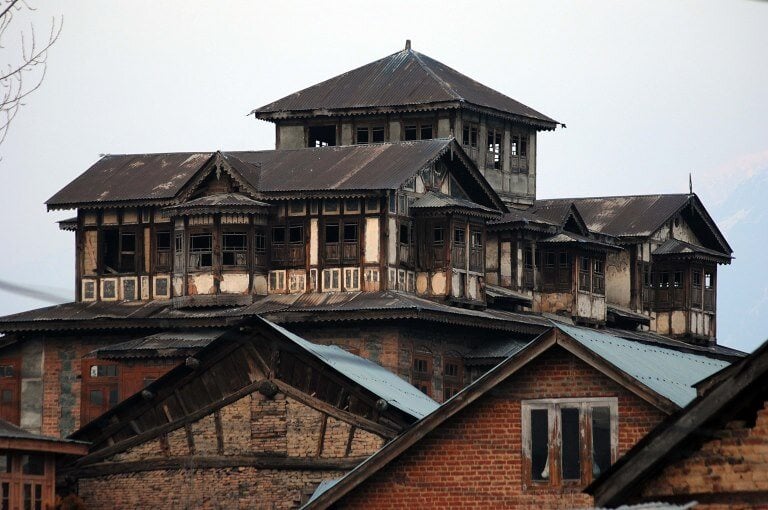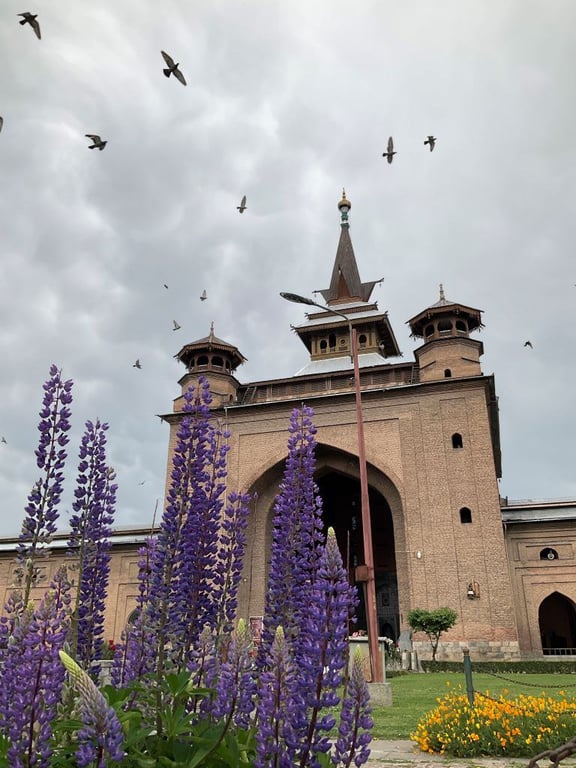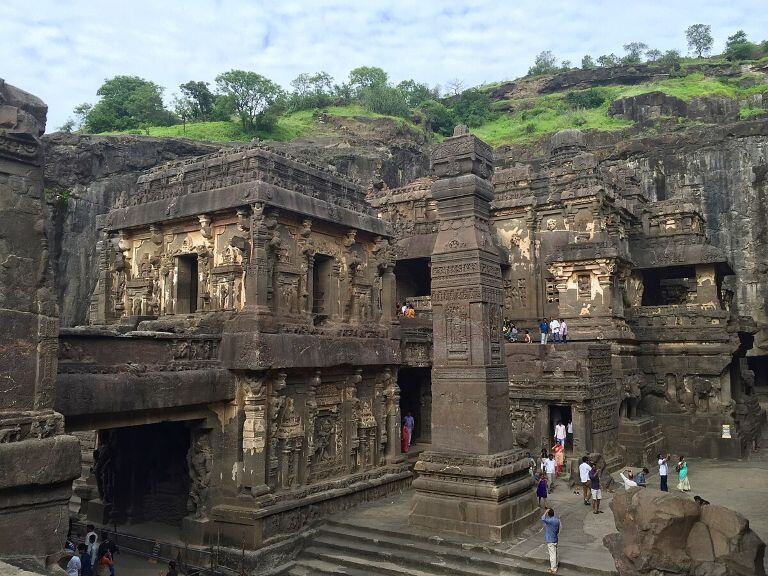
Kashmir's buildings tell the story of its rich past. The beautiful valley, surrounded by mountains, has seen many rulers come and go, each adding to how buildings look in the region. From old Hindu temples to grand Mughal gardens, from Buddhist places of worship to Islamic shrines, Kashmir architecture shows how different cultures have shaped the area. These remarkable buildings have withstood the test of time, maintaining their beauty and significance.
History of Kashmiri Architecture
The art and architecture of Kashmir has changed over time:
Ancient Period (3000 BCE - 1339 CE):
The oldest buildings in Kashmir date back thousands of years, with early settlements found at Burzahom and Gufkral. Hindu and Buddhist styles were common, with stone temples with pyramid-shaped roofs. The Martand Sun Temple, built in the 8th century, shows how grand ancient Kashmir buildings could be.
Islamic Period (1339 - 1586 CE):
When the Shah Mir rulers took over, Islamic building styles began to appear. Sultan Zain-ul-Abidin (1420-1470 CE), known as "Budshah," supported many building projects. During this time, wooden mosques with tall spires and detailed carvings became common.
Mughal Period (1586 - 1752 CE):
The Mughals brought new styles to Kashmir architecture with beautiful gardens, like Shalimar Bagh, Nishat Bagh, and Chashme Shahi. Mughal architecture in Kashmir used local materials and designs that worked well in the local weather.
Afghan Period (1752 - 1819 CE):
Not many new buildings were made during this time, but existing ones were kept up with some changes.
Sikh Period (1819 - 1846 CE):
The Sikh rulers built military structures and strengthened existing forts, like Hari Parbat.
Dogra Period (1846 - 1947 CE):
The Dogra rulers supported traditional building styles while slowly adding European influences, especially in Jammu.
After 1947:
Modern houses in Kashmir often mix old styles with new designs.
Want to learn how to apply new technology to traditional designs like those in Kashmir? The PGP in Building Information Modeling (BIM) for Architects shows how BIM can make traditional architecture more effective and accurate.
Key Features of Architecture in Kashmir

- Wood-Based Building: Wood has become the main building material because of the prevalence of many forests and frequent earthquakes. Deodar cedar wood, which lasts long and keeps insects away, was often used in traditional houses in Kashmir.
- Weather-Smart Design: The cold winters and mild summers shaped how buildings were made. Features like the "Hamam" (a heating system) and small windows help keep heat inside during winter.
- Detailed Woodwork: Beautiful wooden ceiling patterns (khatamband), lattice work (pinjrakari), and carvings show the great skill of Kashmir's craftspeople.
When the Mughals conquered Kashmir in 1586 under Emperor Akbar, they brought their sophisticated architectural traditions to the region. The valley’s natural beauty deeply impressed the Mughal rulers, especially Emperor Jahangir, who is believed to have echoed the famous line by poet Amir Khusrau: “If there is a paradise on earth, it is this, it is this, it is this.”
Thereafter, Mughal architecture in Kashmir introduced step-like gardens, decorated pavilions, nature-focused designs, fountains and pools and beautiful details.
Styles of Architecture in Kashmir
Kashmir's buildings can be grouped into several styles:
- Hindu-Buddhist Style: Stone temples with pyramid-shaped roofs, thick walls, and detailed carvings. The building rules followed the Nagara and Vesara styles with local changes.
- Islamic Style: Wooden mosques with tower-like spires, artistic writing, and pattern work. The Shah Hamdan Mosque's unique style mixes Central Asian ideas with local traditions.
- Mughal Style: Gardens with step-like layouts, pavilions, water channels, and decorative features. These structures work well with Kashmir's natural landscape.
Kashmir architecture also reflects local building traditions that have been developed to suit the region’s needs. The vernacular architecture of Kashmir showcases these traditions, developed over centuries:
- Dhajji-dewari: A wooden frame filled with bricks that helps buildings survive earthquakes
- Taq System: Stone walls strengthened with wooden beams
- Khatamband Ceilings: Detailed wooden ceiling patterns put together without nails
Quick Facts
- The name "Kashmir" comes from old Sanskrit, meaning "land of Kashyap Rishi"
- Khatamband ceiling work uses over 100 different patterns
- Kashmiri buildings often use walnut wood because it lasts long and looks good
- The Shah Hamdan Mosque has been rebuilt three times after fires
Also Read - Architectural Heritage of Nagaland: Unique Monuments & Tribal Structures
Stunning Examples of Kashmiri Art & Architecture

1. Shankaracharya Temple, Srinagar
Built in 371 BCE for Lord Shiva, this stone temple sits on top of a hill looking over Dal Lake. It follows the ancient Nagara style with a round inner room and impressive stonework. The temple was renovated several times during Mughal Emperor Shah Jahan's rule.
2. Jamia Masjid, Srinagar
First built in 1394 CE by Sultan Sikandar Butshikan and rebuilt many times, this big mosque shows Indo-Saracenic architecture. The building has 370 wooden columns holding up the roof, with a courtyard big enough for many people to pray. Its tower-like spires show how Central Asian and local building styles mixed.
3. Hari Parbat Fort, Srinagar
Started by Akbar the Great in 1590 CE and finished by Afghan Governor Atta Mohammad Khan in 1808, this fort shows a military building adapted to the mountain area. Built with local grey limestone, its huge walls stretch over 5 kilometres with many strong points and gates.
4. Shalimar Bagh, Srinagar
Made by Emperor Jahangir for his wife Nur Jahan in 1619, this garden shows the best of Mughal architecture in Kashmir. The garden has the classic four-part layout with three levels, each 4 meters higher than the one below. The black marble pavilion has fine writing and detailed stonework.
5. Shah Hamdan Mosque, Srinagar
Also known as Khanqah-e-Moula, this wooden mosque was first built in 1395 and rebuilt several times after fires. The building shows the best examples of vernacular architecture in Kashmir with its tower-like roof, detailed wooden ceilings, carvings, and paper-mache work inside.
Also Read - Exploring the Majestic Heritage Art & Architecture of Maharashtra
Conclusion
Kashmir's old forts and shrines are lasting symbols of the region's building skills and cultural mix. From ancient stone temples to wooden mosques and stunning Mughal gardens to local homes, the art and architecture of Jammu and Kashmir reflect the growth of art and the merging of different cultures.
To learn how to combine traditional and modern design techniques, enrol in the BIM Professional Course For Architects by Novatr. This course provides you with in-demand skills that make your architectural expertise highly marketable in today's competitive industry. By learning advanced design methods, you'll be prepared to create innovative, sustainable structures that meet the needs of modern communities.
Looking for up-to-date AEC industry information? Check out our Novatr resource page for more details.
Frequently Asked Questions:
1. What is the architectural style of Kashmir?
Kashmir architecture combines Hindu, Buddhist, and Islamic influences. It includes wooden designs, sloping roofs, and stone structures, with local materials like wood and stone used in construction.
2. What is the architecture of the temples in Kashmir?
Kashmiri temples are built with stone, featuring detailed carvings and tiered roofs. They reflect traditional Hindu design with symbolic religious decorations.
Was this content helpful to you



.jpg)






.png)
